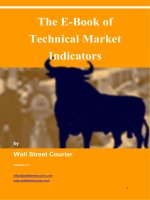Burton g malkiel a random walk down wall street ing
Bạn đang xem bản rút gọn của tài liệu. Xem và tải ngay bản đầy đủ của tài liệu tại đây (4.59 MB, 318 trang )
A RANDOM WALK DOWN WALL STREET
A RANDOM WALK DOWN WALL STREET
The Time-Tested Strategy for Successful Investing
BURTON G. MALKIEL
W. W. NORTON & COMPANY
New York • London
Copyright © 2011, 2007, 2003, 1999, 1996, 1990, 1985, 1981, 1975, 1973 by W. W. Norton &
Company, Inc.
The article on page 324 entitled “Red Faces in Park” appears courtesy of Thomson Reuters. All
rights reserved. Republication or redistribution of Thomson Reuters content, including by framing or
similar means, is expressly prohibited without the prior written consent of Thomson Reuters.
Thomson Reuters and its logo are registered trademarks or trademarks of the Thomson Reuters group
of companies around the world. © Thomson Reuters 2009. Thomson Reuters journalists are subject to
an Editorial Handbook, which requires fair presentation and disclosure of relevant interests.
All rights reserved
For information about permission to reproduce selections from this book, write to Permissions, W.
W. Norton & Company, Inc., 500 Fifth Avenue, New York, NY 10110
Library of Congress Cataloging-in-Publication Data
Malkiel, Burton Gordon.
A random walk down Wall Street: the time-tested strategy for successful investing / Burton G.
Malkiel.
p. cm.
Rev. ed.
ISBN: 978-0-393-08169-5
1. Investments. 2. Stocks. 3. Random walks (Mathematics) I. Title.
HG4521.M284 2011
332.601’519282—dc22
2010041866
W. W. Norton & Company, Inc.
500 Fifth Avenue, New York, N.Y. 10110
www.wwnorton.com
W. W. Norton & Company Ltd.
Castle House, 75/76 Wells Street, London W1T 3QT
TO NANCY AND SKIPPER
CONTENTS
Preface
Acknowledgments from Earlier Editions
Part One
STOCKS AND THEIR VALUE
1. FIRM FOUNDATIONS AND CASTLES IN THE AIR
What Is a Random Walk?
Investing as a Way of Life Today
Investing in Theory
The Firm-Foundation Theory
The Castle-in-the-Air Theory
How the Random Walk Is to Be Conducted
2. THE MADNESS OF CROWDS
The Tulip-Bulb Craze
The South Sea Bubble
Wall Street Lays an Egg
An Afterword
3 . SPECULATIVE BUBBLES FROM THE SIXTIES INTO
THE NINETIES
The Sanity of Institutions
The Soaring Sixties
The New “New Era”: The Growth-Stock/New-Issue Craze
Synergy Generates Energy: The Conglomerate Boom
Performance Comes to the Market: The Bubble in Concept Stocks
The Nifty Fifty
The Roaring Eighties
The Return of New Issues
Concepts Conquer Again: The Biotechnology Bubble
ZZZZ Best Bubble of All
What Does It All Mean?
The Japanese Yen for Land and Stocks
4. THE EXPLOSIVE BUBBLES OF THE EARLY 2000S
The Internet Bubble
A Broad-Scale High-Tech Bubble
Yet Another New-Issue Craze
TheGlobe.com
Security Analysts $peak Up
New Valuation Metrics
The Writes of the Media
Fraud Slithers In and Strangles the Market
Should We Have Known the Dangers?
The U.S. Housing Bubble and Crash of the Early 2000s
The New System of Banking
Looser Lending Standards
The Housing Bubble
Bubbles and Economic Activity
Does This Mean That Markets Are Inefficient?
Part Two
HOW THE PROS PLAY THE BIGGEST GAME IN TOWN
5. TECHNICAL AND FUNDAMENTAL ANALYSIS
Technical versus Fundamental Analysis
What Can Charts Tell You?
The Rationale for the Charting Method
Why Might Charting Fail to Work?
From Chartist to Technician
The Technique of Fundamental Analysis
Three Important Caveats
Why Might Fundamental Analysis Fail to Work?
Using Fundamental and Technical Analysis Together
6 . TECHNICAL ANALYSIS AND THE RANDOM-WALK
THEORY
Holes in Their Shoes and Ambiguity in Their Forecasts
Is There Momentum in the Stock Market?
Just What Exactly Is a Random Walk?
Some More Elaborate Technical Systems
The Filter System
The Dow Theory
The Relative-Strength System
Price-Volume Systems
Reading Chart Patterns
Randomness Is Hard to Accept
A Gaggle of Other Technical Theories to Help You Lose Money
The Hemline Indicator
The Super Bowl Indicator
The Odd-Lot Theory
A Few More Systems
Technical Market Gurus
Why Are Technicians Still Hired?
Appraising the Counterattack
Implications for Investors
7. HOW GOOD IS FUNDAMENTAL ANALYSIS?
The Views from Wall Street and Academia
Are Security Analysts Fundamentally Clairvoyant?
Why the Crystal Ball Is Clouded
1. The Influence of Random Events
2. The Production of Dubious Reported Earnings through
“Creative” Accounting Procedures
3. Errors Made by the Analysts Themselves
4. The Loss of the Best Analysts to the Sales Desk, to Portfolio
Management, or to Hedge Funds
5. The Conflicts of Interest between Research and Investment
Banking Departments
Do Security Analysts Pick Winners?—The Performance of the
Mutual Funds
Can Any Fundamental System Pick Winners?
The Verdict on Market Timing
The Semi-Strong and Strong Forms of the Efficient-Market Theory
The Middle of the Road: A Personal Viewpoint
Part Three
THE NEW INVESTMENT TECHNOLOGY
8 . A NEW WALKING SHOE: MODERN PORTFOLIO
THEORY
The Role of Risk
Defining Risk: The Dispersion of Returns
Illustration: Expected Return and Variance Measures of Reward
and Risk
Documenting Risk: A Long-Run Study
Reducing Risk: Modern Portfolio Theory (MPT)
Diversification in Practice
9. REAPING REWARD BY INCREASING RISK
Beta and Systematic Risk
The Capital-Asset Pricing Model (CAPM)
Let’s Look at the Record
An Appraisal of the Evidence
The Quant Quest for Better Measures of Risk: Arbitrage Pricing
Theory
The Fama-French Three-Factor Model
A Summing Up
10. BEHAVIORAL FINANCE
The Irrational Behavior of Individual Investors
Overconfidence
Biased Judgments
Herding
Loss Aversion
Pride and Regret
Behavioral Finance and Savings
The Limits to Arbitrage
What Are the Lessons for Investors from Behavioral Finance?
1. Avoid Herd Behavior
2. Avoid Overtrading
3. If You Do Trade: Sell Losers, Not Winners
4. Other Stupid Investor Tricks
Does Behavioral Finance Teach Ways to Beat the Market?
11. POTSHOTS AT THE EFFICIENT-MARKET THEORY
AND WHY THEY MISS
What Do We Mean by Saying Markets Are Efficient?
Potshots That Completely Miss the Target
Dogs of the Dow
January Effect
“Thank God It’s Monday Afternoon” Pattern
Hot News Response
Why the Aim Is So Bad
Potshots That Get Close but Still Miss the Target
The Trend Is Your Friend (Otherwise Known as Short-Term
Momentum)
The Dividend Jackpot Approach
The Initial P/E Predictor
The “Back We Go Again” Strategy (Otherwise Known as Long-
Run Return Reversals)
The “Smaller Is Better” Effect
The “Value Will Win” Record
Stocks with Low Price-Earnings Multiples Outperform Those with
High Multiples
Stocks That Sell at Low Multiples of Their Book Values Tend to
Produce Higher Subsequent Returns
Does “Value” Really Trump Growth on a Consistent Basis?
Why Even Close Shots Miss
And the Winner Is…
The Performance of Professional Investors
A Summing Up
Part Four
A PRACTICAL GUIDE FOR RANDOM WALKERS AND
OTHER INVESTORS
12. A FITNESS MANUAL FOR RANDOM WALKERS
Exercise 1: Gather the Necessary Supplies
Exercise 2: Don’t Be Caught Empty-Handed: Cover Yourself with
Cash Reserves and Insurance
Cash Reserves
Insurance
Deferred Variable Annuities
Exercise 3: Be Competitive—Let the Yield on Your Cash Reserve
Keep Pace with Inflation
Money-Market Mutual Funds (Money Funds)
Bank Certificates of Deposit (CDs)
Internet Banks
Treasury Bills
Tax-Exempt Money-Market Funds
Exercise 4: Learn How to Dodge the Tax Collector
Individual Retirement Accounts
Roth IRAs
Pension Plans
Saving for College: As Easy as 529
Exercise 5: Make Sure the Shoe Fits: Understand Your Investment
Objectives
Exercise 6: Begin Your Walk at Your Own Home—Renting Leads
to Flabby Investment Muscles
Exercise 7: Investigate a Promenade through Bond Country
Zero-Coupon Bonds Can Generate Large Future Returns
No-Load Bond Funds Are Appropriate Vehicles for Individual
Investors
Tax-Exempt Bonds Are Useful for High-Bracket Investors
Hot TIPS: Inflation-Indexed Bonds
Should You Be a Bond-Market Junkie?
Exercise 8: Tiptoe through the Fields of Gold, Collectibles, and
Other Investments
Exercise 9: Remember That Commission Costs Are Not Random;
Some Are Lower than Others
Exercise 10: Avoid Sinkholes and Stumbling Blocks: Diversify
Your Investment Steps
A Final Checkup
13. HANDICAPPING THE FINANCIAL RACE: A PRIMER
IN UNDERSTANDING AND PROJECTING RETURNS
FROM STOCKS AND BONDS
What Determines the Returns from Stocks and Bonds?
Four Eras of Financial Market Returns
Era I: The Age of Comfort
Era II: The Age of Angst
Era III: The Age of Exuberance
Era IV: The Age of Disenchantment
Handicapping Future Returns
14. A LIFE-CYCLE GUIDE TO INVESTING
Five Asset-Allocation Principles
1. Risk and Reward Are Related
2. Your Actual Risk in Stock and Bond Investing Depends on the
Length of Time You Hold Your Investment
3. Dollar-Cost Averaging Can Reduce the Risks of Investing in
Stocks and Bonds
4. Rebalancing Can Reduce Investment Risk and Possibly Increase
Returns
5. Distinguishing between Your Attitude toward and Your
Capacity for Risk
Three Guidelines to Tailoring a Life-Cycle Investment Plan
1. Specific Needs Require Dedicated Specific Assets
2. Recognize Your Tolerance for Risk
3. Persistent Saving in Regular Amounts, No Matter How Small,
Pays Off
The Life-Cycle Investment Guide
Life-Cycle Funds
Investment Management Once You Have Retired
Inadequate Preparation for Retirement
Investing a Retirement Nest Egg
Annuities
The Do-It-Yourself Method
15. THREE GIANT STEPS DOWN WALL STREET
The No-Brainer Step: Investing in Index Funds
The Index-Fund Solution: A Summary
A Broader Definition of Indexing
A Specific Index-Fund Portfolio
ETFs and the Tax-Managed Index Fund
The Do-It-Yourself Step: Potentially Useful Stock-Picking Rules
Rule 1: Confine stock purchases to companies that appear able to
sustain above-average earnings growth for at least five years
Rule 2: Never pay more for a stock than can reasonably be
justified by a firm foundation of value
Rule 3: It helps to buy stocks with the kinds of stories of
anticipated growth on which investors can build castles in the
air
Rule 4: Trade as little as possible
The Substitute-Player Step: Hiring a Professional Wall Street
Walker
The Morningstar Mutual-Fund Information Service
The Malkiel Step
A Paradox
Some Last Reflections on Our Walk
A Final Word
A Random Walker’s Address Book and Reference Guide to Mutual
Funds
PREFACE
IT HAS NOW been forty years since I began writing the first edition of A Random Walk Down Wall
Street. The message of the original edition was a very simple one: Investors would be far better off
buying and holding an index fund than attempting to buy and sell individual securities or actively
managed mutual funds. I boldly stated that buying and holding all the stocks in a broad stock-market
average was likely to outperform professionally managed funds whose high expense charges and
large trading costs detract substantially from investment returns.
Now, forty years later, I believe even more strongly in that original thesis, and there’s more than
a six-figure gain to prove it. I can make the case with great simplicity. An investor with $10,000 at
the start of 1969 who invested in a Standard & Poor’s 500-Stock Index Fund would have had a
portfolio worth $463,000 by 2010, assuming that all dividends were reinvested. A second investor
who instead purchased shares in the average actively managed fund would have seen his investment
grow to $258,000. The difference is dramatic. Through May 30, 2010, the index investor was ahead
by $205,000, an amount almost 80 percent greater than the final stake of the average investor in a
managed fund.
Why, then, a tenth edition of this book? If the basic message hasn’t changed, what has? The
answer is that there have been enormous changes in the financial instruments available to the public.
A book meant to provide a comprehensive investment guide for individual investors needs to be
updated to cover the full range of investment products available. In addition, investors can benefit
from a critical analysis of the wealth of new information provided by academic researchers and
market professionals—made comprehensible in prose accessible to everyone with an interest in
investing. There have been so many bewildering claims about the stock market that it’s important to
have a book that sets the record straight.
Over the past forty years, we have become accustomed to accepting the rapid pace of
technological change in our physical environment. Innovations such as e-mail, the Internet, iPhones,
iPads, Kindles, videoconferencing, social networks, and new medical advances ranging from organ
transplants and laser surgery to nonsurgical methods of treating kidney stones and unclogging arteries
have materially affected the way we live. Financial innovation over the same period has been equally
rapid. In 1973, when the first edition of this book appeared, we did not have money-market funds,
NOW accounts, ATMs, index mutual funds, ETFs, tax-exempt funds, emerging-market funds, target-
date funds, floating-rate notes, volatility derivatives, inflation protection securities, equity REITs,
asset-backed securities, Roth IRAs, 529 college savings plans, zero-coupon bonds, financial and
commodity futures and options, and new trading techniques such as “portfolio insurance” and “flash
trading,” to mention just a few of the changes that have occurred in the financial environment. Much of
the new material in this book has been included to explain these financial innovations and to show
how you as a consumer can benefit from them.
This tenth edition also provides a clear and easily accessible description of the academic
advances in investment theory and practice. Chapter 10 describes the exciting new field of behavioral
finance and underscores the important lessons investors should learn from the insights of the
behavioralists. In addition, a new section has been added to present practical investment strategies
for investors who have retired or are about to retire. So much new material has been added over the
years that readers who may have read an earlier edition of this book in college or business school
will find this new edition rewarding reading.
This edition takes a hard look at the basic thesis of earlier editions of Random Walk—that the
market prices stocks so efficiently that a blindfolded chimpanzee throwing darts at the stock listings
can select a portfolio that performs as well as those managed by the experts. Through the past forty
years, that thesis has held up remarkably well. More than two-thirds of professional portfolio
managers have been outperformed by the unmanaged S&P 500 Index. Nevertheless, there are still
both academics and practitioners who doubt the validity of the theory. And the stock-market crash of
October 1987, the Internet bubble, and the financial crisis of 2008–09 raised further questions
concerning the vaunted efficiency of the market. This edition explains the recent controversy and
reexamines the claim that it’s possible to “beat the market.” I conclude in chapter 11 that reports of
the death of the efficient-market theory are vastly exaggerated. I will, however, review the evidence
on a number of techniques of stock selection that are believed to tilt the odds of success in favor of
the individual investor.
The book remains fundamentally a readable investment guide for individual investors. As I have
counseled individuals and families about financial strategy, it has become increasingly clear to me
that one’s capacity for risk-bearing depends importantly upon one’s age and ability to earn income
from noninvestment sources. It is also the case that the risk involved in most investments decreases
with the length of time the investment can be held. For these reasons, optimal investment strategies
must be age-related. Chapter 14, entitled “A Life-Cycle Guide to Investing,” should prove very
helpful to people of all ages. This chapter alone is worth the cost of a high-priced appointment with a
personal financial adviser.
My debts of gratitude to those mentioned in earlier editions continue. In addition, I must mention
the names of a number of people who were particularly helpful in making special contributions to the
tenth edition. I am especially indebted to Kevin Laughlin of the Bogle Research Institute, to my
Princeton colleague Harrison Hong, and to my research assistants, David Hou, Derek Jun, and
Saumitra Sahi. I am also grateful to John Devereaux, Christopher Philips, and Cheryl Roberts of the
Vanguard Group for their important assistance in providing data.
Ellen DiPippo made an extraordinary contribution to this edition. She was somehow able to
decipher my inpenetrable scribbles and turn them into readable text. She also provided research
assistance and was responsible for most of the graphic presentations in the book. My association with
W. W. Norton remains a superb collaboration, and I thank Drake McFeely and Jeff Shreve for their
indispensable assistance in bringing this edition to publication. Patricia Taylor continued her
association with the project and made extremely valuable editorial contributions to the tenth edition.
My wife, Nancy Weiss Malkiel, has made by far the most important contributions to the
successful completion of the past six editions. In addition to providing the most loving encouragement
and support, she read carefully through various drafts of the manuscript and made innumerable
suggestions that clarified and vastly improved the writing. She continues to be able to find errors that
have eluded me and a variety of proofreaders and editors. Most important, she has brought incredible
joy to my life. No one more deserved the dedication of a book than she and her second-best friend.
Burton G. Malkiel
Princeton University
September 2010
ACKNOWLEDGMENTS
from Earlier Editions
MY DEBTS OF GRATITUDE to practitioners, financial institutions, and academic colleagues who
have helped me with the earlier editions of this book are enormous in both number and degree. Here,
I acknowledge the many individuals who offered extremely valuable suggestions and criticisms.
Many research assistants have labored long in compiling information for this book. Especially
useful contributions were made by John Americus, Shane Antos, Costin Bontas, Jonathan Curran,
Barry Feldman, Ethan Hugo, Amie Ko, Paul Messaris, Matthew Moore, Ker Moua, Ellen Renaldi,
Barry Schwartz, Greg Smolarek, Ray Soldavin, Elizabeth Woods, Yexiao Xu, and Basak Yeltikan.
Helen Talar, Phyllis Fafalios, Lugene Whitley, Melissa Orlowski, and Diana Prout not only faithfully
and accurately typed several drafts of the manuscript but also offered extremely valuable research
assistance. Elvira Giaimo provided most helpful computer programming. Many of the supporting
studies for this book were conducted at Princeton’s Bendheim Center for Finance. I am also grateful
to Arthur Lipper Corporation for permission to use its mutual-fund rankings.
A vital contribution was made by Patricia Taylor, a professional writer and editor. She read
through complete drafts of the book and made innumerable contributions to the style, organization, and
content of the manuscript. She deserves much of the credit for whatever lucid writing can be found in
these pages.
My association with W. W. Norton & Company has been an extremely pleasant one, and I am
particularly grateful to Brendan Curry, Donald Lamm, Robert Kehoe, Ed Parsons, and Deborah
Makay, as well as my editor, Starling Lawrence, for his invaluable help.
The contribution of Judith Malkiel was of inestimable importance. She painstakingly edited
every page of the manuscript and was helpful in every phase of this undertaking. This
acknowledgment of my debt to her is the largest understatement of all.
Finally, I would like to acknowledge with deep gratitude the assistance of the following
individuals who made important contributions to earlier editions. They include: Peter Asch, Leo
Bailey, Howard Baker, Jeffrey Balash, David Banyard, William Baumol, Clair Bien, G. Gordon
Biggar Jr., John Bogle, Lynne Brady, John Brennan, Markus Brunnermeier, Claire Cabelus, Lester
Chandler, Andrew Clarke, Abby Joseph Cohen, Douglas Daniels, Pia Ellen, Andrew Engel, Steve
Feinstein, Barry Feldman, Roger Ford, Stephen Goldfeld, William Grant, Leila Heckman, William
Helman, Roger Ibbotson, Deborah Jenkins, Barbara Johnson, George S. Johnston, Kay Kerr, Walter
Lenhard, James Litvack, Ian MacKinnon, Barbara Mains, Jonathan Malkiel, Sol Malkiel, Whitney
Malkiel, Edward Mathias, Jianping Mei, Melissa McGinnis, Will McIntosh, Kelley Mingone,
William Minicozzi, Keith Mullins, Gabrielle Napolitano, James Norris, Gail Paster, Emily Paster, H.
Bradlee Perry, George Putnam, Donald Peters, Michelle Peterson, Richard Quandt, James Riepe,
Michael Rothschild, Joan Ryan, Robert Salomon Jr., George Sauter, Crystal Shannon, George Smith,
Willy Spat, Shang Song, James Stetler, James Stoeffel, H. Barton Thomas, Mark Thompson, Jim
Troyer, David Twardock, Linda Wheeler, Frank Wisneski, and Robert Zenowich.
Part One
STOCKS AND THEIR VALUE









